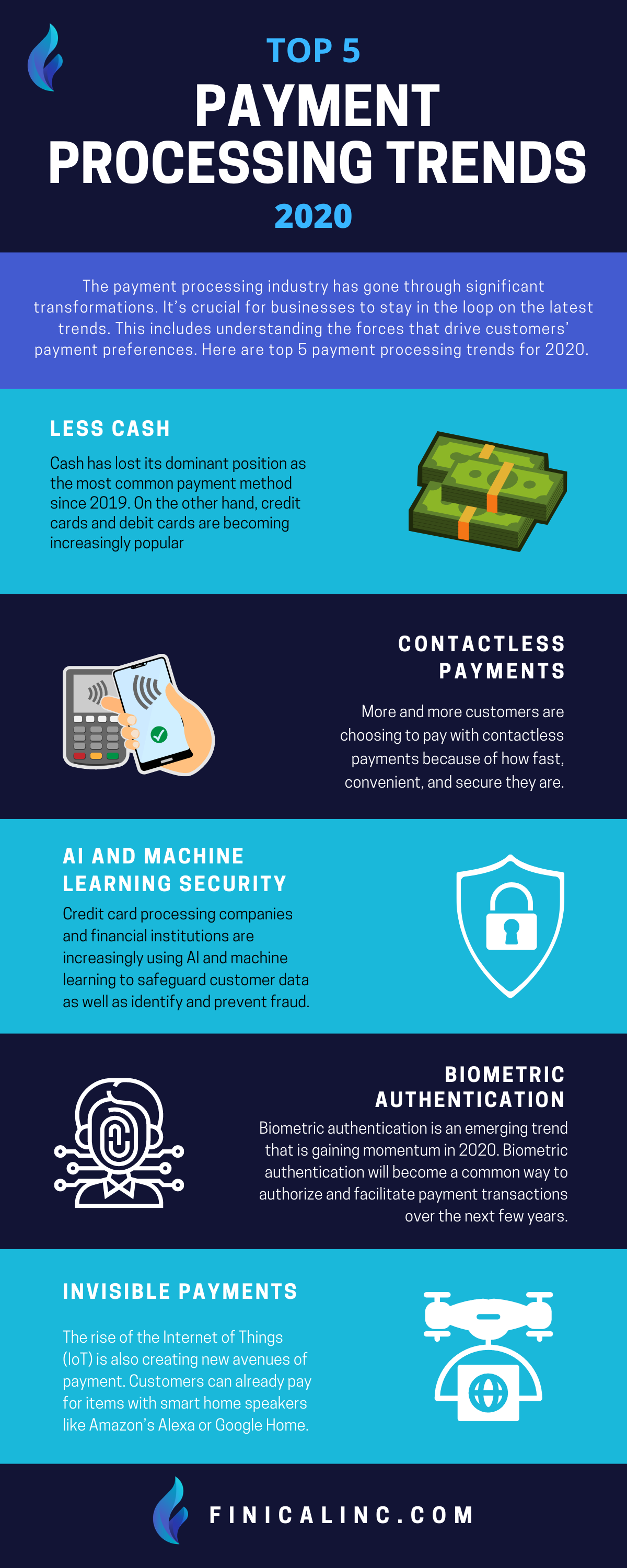From traditional cash registers to mobile POS systems – the payment processing industry has gone through significant transformations. What is certain about the future is that we can expect even more changes in the coming years.
It’s crucial for businesses to stay in the loop on the latest trends. This includes understanding the forces that drive customers’ payment preferences. We’ll go over the top 5 payment processing trends for 2020 and the ways businesses can stay up to date.
Less Cash
The days when cash was the most popular payment method may already be behind us. In 2019, the Federal Reserve reported that cash had lost its dominant position as the most common payment method. On the other hand, credit cards and debit cards are becoming increasingly popular. Digital payment methods are also showing little signs of slowing down. This trend is partially driven by the influx of younger consumers. McKinsey estimates that by 2020, 40% of global consumers will be 23 years old or younger.
Most businesses will benefit from introducing a variety of payment methods at the checkout counter or online. However, businesses whose customers are already paying in cash could benefit from introducing a Dual Pricing program. Dual Pricing programs allow businesses to offer customers a variety of different payment methods without charging hefty credit card processing fees.
Contactless Payments
Contactless payments use near-field communication technology that allows customers to pay by swiping or tapping near a card reader. Contactless payments can apply to smartphones, debit cards, credit cards, and key fobs. More and more customers are choosing to pay with contactless payments because of how fast, convenient, and secure they are.
Mobile wallets also use near-field communication technology. Apple Pay, Samsung Pay, and Google Pay are expected to make up an increasing segment of payment methods over the next few years. A good way businesses can capture this growing market is by accepting mobile payments.
AI and Machine Learning Security
As digital payments, credit cards, and mobile payments continue to grow in popularity there’s also a need for increased consumer protection. Fraud and cybersecurity concerns are at the forefront in 2020 – and are likely to remain a priority for years.
Credit card processing companies and financial institutions are increasingly using AI and machine learning to safeguard customer data as well as identify and prevent fraud. There is also growing collaboration between governments and private companies to develop a regulatory framework. We should expect new regulations to combat transaction risk, payment traceability, and fraud protection in the coming years.
Businesses will need to do their part to ensure they are complying with new regulatory frameworks and meet new consumer data protection standards. They can start by verifying that their credit card processing company is up to date on new regulatory developments.
Biometric authentication
Biometric authentication is an emerging trend that is gaining momentum in 2020. Biometric authentication uses technology to verify the identity of a person based on their biological and physical characteristics. This includes facial, voice, and fingerprint recognition software.
Many people already use some form of biometric authentication to unlock smartphones or gain access to buildings. Watch out for biometric authentication as a way to authorize and facilitate payment transactions over the next few years. Although there is still some time before this technology becomes widespread, it’s nevertheless important to be prepared for its eventual adaptation. A good recommendation is for businesses to work with credit card processing companies that are willing to adapt to new technological shifts.
Invisible Payments
From Amazon to Uber – more companies are using saved payment methods to improve their customers’ experiences. Amazon Go stores have already eliminated the need for a checkout counter entirely. In the coming years, businesses will need to consider new ways to move payment methods to the background.
The rise of the Internet of Things (IoT) is also creating new avenues of payment. Customers can already pay for items with smart home speakers like Amazon’s Alexa or Google Home. In 2020, cars will become interlinked with financial institutions to allow people to purchase gas and other items with their vehicles. Businesses should anticipate heightened awareness and demand for invisible payment methods.
How Businesses Can Prepare for the Future
New technological innovations and changing regulatory frameworks are key forces driving payment trends in 2020. Technological changes have a big impact on customer preferences. Industry standards will affect how businesses can operate. What is certain is that businesses need to be adaptable. Working with a credit card processing company that helps capture future opportunities is critical.

Embed this Infographics On Your Site


